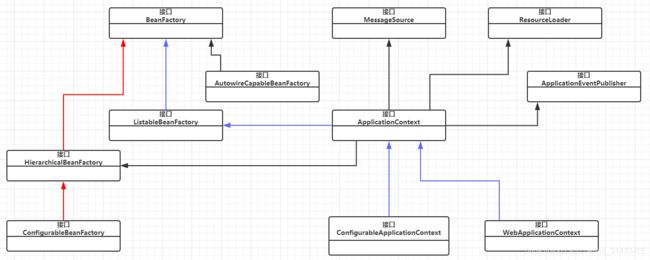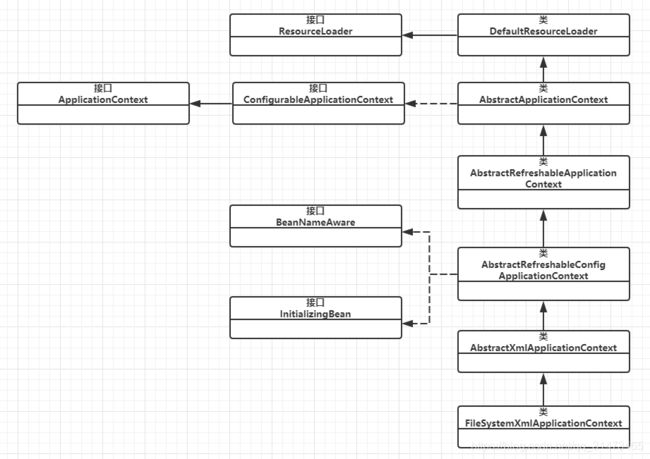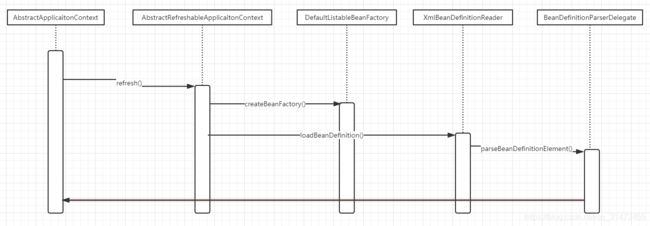Spring----IoC容器源码分析----初始化过程
一、在Spring IoC容器的设计中,有两个主要的容器系列:
- 一个是实现BeanFactory接口的简单容器系列,这系列的容器只实现了容器的最基本功能。
- 另一个是ApplicationContext应用上下文,它作为容器的高级形态而存在。应用上下文在简单容器的基础上,增加了许多面向框架的特性,同时对应用环境作了许多适配。
二、Spring中Ioc容器主要接口设计
- 红色这一条是一条主要的设计路径。
- BeanFactory定义了基本的IoC容器的规范。包括了getBean()这样的IoC容器的基本方法(从容器中获取Bean)。
- HierarchicalBeanFactory接口在继承BeanFactory之后,增加了getParentBeanFactory()的接口功能,使BeanFactory具备了双亲IoC容器的管理功能。
- ConfigurableBeanFactory接口中,主要定义了一些对BeanFactory的配置功能。比如通过setParentBeanFactory()设置双亲IoC容器,addBeanPostProcessor()配置Bean后置处理。
- 蓝色线是以ApplicationContext为核心的接口设计
- 在ListableBeanFactory中,细化了许多BeanFactory的接口功能,比如getBeanDefinitionNames()方法。
- HierarchicalBeanFactory上面提到了。
- ApplicationContext接口,通过集成MessageSource、ResourceLoader、ApplicationEventPublisher接口,在BeanFactory简单IoC容器的基础上添加了许多对高级容器的支持。
- DefaultListableBeanFactory,这个基本IoC容器的实现就是实现了ConfigurableBeanFactory,从而成为一个简单的IoC容器的实现。XmlBeanFactory都是在DefaultListableBeanFactory基础上做扩展。
三、IoC容器的初始化过程
简单来说,IoC容器的初始化是由AbstractApplicationContext中的refresh()方法来启动的,这个方法标志着IoC容器的正式启动。具体分为:BeanDifinition的Resource定位、载入和注册三个基本过程。Spring把这三个过程分开,可以让用户更加灵活地对这三个过程进行剪裁或扩展。
3.1 BeanDifiniton的Resource定位
- 以编程方式使用DefaultListableBeanFactory时,首先定义一个Resource来定位容器使用的BeanDifinition。这时使用的是ClassPathResource,这时Spring会在类路径中去寻找一文件形式存在的BeanDifinition信息。这里定义的Resource需要通过BeanDefinitionReader来进行处理。
ClassPathResource classPathResource = new ClassPathResource("/beans.xml");- 以FileSystemXmlApplicationContext为例,下图是相应的继承关系
从上图中可看出,FileSystemXmlApplicationContext通过继承AbstractApplicationContext具备了ResourceLoader读入以Rescource定义的BeanDefinition的能力。代码内容如下:
public class FileSystemXmlApplicationContext extends AbstractXmlApplicationContext {
public FileSystemXmlApplicationContext() {
}
public FileSystemXmlApplicationContext(ApplicationContext parent) {
super(parent);
}
//这个构造函数的configLocation包含的是BeanDefiniton所在的文件路径。
public FileSystemXmlApplicationContext(String configLocation) throws BeansException {
this(new String[] {configLocation}, true, null);
}
//这个构造函数的允许configLocation包含多个BeanDefiniton所在的文件路径。
public FileSystemXmlApplicationContext(String... configLocations) throws BeansException {
this(configLocations, true, null);
}
//这个构造函数的允许configLocation包含多个BeanDefiniton所在的文件路径,且还允许指定自己的双
//亲IoC容器
public FileSystemXmlApplicationContext(String[] configLocations, ApplicationContext parent) throws BeansException {
this(configLocations, true, parent);
}
public FileSystemXmlApplicationContext(String[] configLocations, boolean refresh) throws BeansException {
this(configLocations, refresh, null);
}
//在对象的初始化过程中,调用refresh函数载入BeanDefition,这个refresh启动了BeanDefinition的
//载入过程
public FileSystemXmlApplicationContext(
String[] configLocations, boolean refresh, @Nullable ApplicationContext parent)
throws BeansException {
super(parent);
setConfigLocations(configLocations);
if (refresh) {
refresh();
}
}
//这个是应用于文件系统中Rescource的实现,通过构造一个FileSystemResource来得到一个在文件系统
//中定位的BeanDefition,这个getResourceByPath是在BeanDefinitionReader的
//loadBeanDefinition中被调用的,loadBeanDefinition采用了模板模式,具体的定位实现实际上是由
//各个子类来完成的。
@Override
protected Resource getResourceByPath(String path) {
if (path.startsWith("/")) {
path = path.substring(1);
}
return new FileSystemResource(path);
}
}- 在初始化FileSystemXmlApplicationContext的过程中,通过IoC容器的初始化的refresh来启动整个调用,使用的IoC容器是DefaultListableBeanFactory。具体的资源载入在XmlBeanDefinitonReader读入BeanDefinition时完成,在XmlBeanDefinitonReader的基类AbstractBeanDefinitionReader中可以看到这个载入过程的具体实现。
- AbstractRefreshableApplicationContext对容器的初始化
@Override
protected final void refreshBeanFactory() throws BeansException {
//判断,如果已经建立了BeanFactory,则销毁并关闭改BeanFactory
if (hasBeanFactory()) {
destroyBeans();
closeBeanFactory();
}
//这里是创建并设置持有的DefaultListableBeanFactory的地方同时调用loadBeanDefinitions()再载入BeanDefinition的信息
try {
DefaultListableBeanFactory beanFactory = createBeanFactory();
beanFactory.setSerializationId(getId());
customizeBeanFactory(beanFactory);
loadBeanDefinitions(beanFactory);
synchronized (this.beanFactoryMonitor) {
this.beanFactory = beanFactory;
}
}
catch (IOException ex) {
throw new ApplicationContextException("I/O error parsing bean definition source for " + getDisplayName(), ex);
}
}
/**
* 这就是在上下文中创建DefaultListableBeanFactory的地方,而getInternalParentBeanFactory()的具体实现可以参看AbstractApplicationContext
* 中的实现,会根据容器已有的双亲IoC容器的信息来生成DefaultListableBeanFactory的双亲Ioc容器
* @return
*/
protected DefaultListableBeanFactory createBeanFactory() {
return new DefaultListableBeanFactory(getInternalParentBeanFactory());
}//AbstractBeanDefinitionReader中loadBeanDefinitions具体实现
public int loadBeanDefinitions(String location, @Nullable Set actualResources) throws BeanDefinitionStoreException {
//这里取得ResourceLoader,使用的是DefaultResourceLoader
ResourceLoader resourceLoader = getResourceLoader();
if (resourceLoader == null) {
throw new BeanDefinitionStoreException(
"Cannot load bean definitions from location [" + location + "]: no ResourceLoader available");
}
//这里对Resource的路径模式进行解析,比如我们设定的各种Ant格式的路径定义,得到需要的Resource集合,这些Resource集合指向
//我们已经定义好的BeanDefinition信息,可以是多个文件。
if (resourceLoader instanceof ResourcePatternResolver) {
// Resource pattern matching available.
try {
//调用DefaultResourceLoader的getResources()完成具体的Resource定位。
Resource[] resources = ((ResourcePatternResolver) resourceLoader).getResources(location);
int count = loadBeanDefinitions(resources);
if (actualResources != null) {
Collections.addAll(actualResources, resources);
}
if (logger.isTraceEnabled()) {
logger.trace("Loaded " + count + " bean definitions from location pattern [" + location + "]");
}
return count;
}
catch (IOException ex) {
throw new BeanDefinitionStoreException(
"Could not resolve bean definition resource pattern [" + location + "]", ex);
}
}
else {
// Can only load single resources by absolute URL.
Resource resource = resourceLoader.getResource(location);
int count = loadBeanDefinitions(resource);
if (actualResources != null) {
actualResources.add(resource);
}
if (logger.isTraceEnabled()) {
logger.trace("Loaded " + count + " bean definitions from location [" + location + "]");
}
return count;
}
}
//DefaultResourceLoader的具体定位过程
@Override
public Resource getResource(String location) {
Assert.notNull(location, "Location must not be null");
for (ProtocolResolver protocolResolver : this.protocolResolvers) {
Resource resource = protocolResolver.resolve(location, this);
if (resource != null) {
return resource;
}
}
if (location.startsWith("/")) {
return getResourceByPath(location);
}
//这里处理带有classpath标识的Resource
else if (location.startsWith(CLASSPATH_URL_PREFIX)) {
return new ClassPathResource(location.substring(CLASSPATH_URL_PREFIX.length()), getClassLoader());
}
else {
try {
//这里处理URL标识的Resource
URL url = new URL(location);
return (ResourceUtils.isFileURL(url) ? new FileUrlResource(url) : new UrlResource(url));
}
catch (MalformedURLException ex) {
//如果既不是classpath也不是URL标识的Resource定位,则交给getResourceByPath,默认是得到一个ClassPathContextResource
//,这个方法往往子类来实现。
return getResourceByPath(location);
}
}
} //FileSystemXmlApplicationContext的重写,如果是其他的ApplicationContext就会生成其他种类
@Override
protected Resource getResourceByPath(String path) {
if (path.startsWith("/")) {
path = path.substring(1);
}
return new FileSystemResource(path);
}3.2 BeanDefinition的载入和解析.
- 对IoC容器来说,这个载入过程,相当于把定义的BeanDefinition在IoC容器中转化成一个Spring内部表示的数据结构的过程。
- 首先IoC容器的初始化入口,就是AbstractApplicationContext的refresh()方法,它详细的描述了整个ApplicationContext的初始化过程,比如BeanFactory的更新,MessageSource和PostProcessor的注册等等。
下面是refresh()的代码:
public void refresh() throws BeansException, IllegalStateException {
synchronized (this.startupShutdownMonitor) {
// Prepare this context for refreshing.
prepareRefresh();
//这是子类启动refreshBeanFactory()的地方
ConfigurableListableBeanFactory beanFactory = obtainFreshBeanFactory();
//设置一些BeanFactory参数
prepareBeanFactory(beanFactory);
try {
//设置BeanFactory的后置处理
postProcessBeanFactory(beanFactory);
// 调用BeanFactory的后处理器,这些后处理器是在Bean定义中向容器注册的
invokeBeanFactoryPostProcessors(beanFactory);
// 注册Bean的后处理器,在Bean创建过程中调用
registerBeanPostProcessors(beanFactory);
// 对上下文中的消息源进行初始化
initMessageSource();
// 初始化上下文中的事件机制
initApplicationEventMulticaster();
// 初始化其他的特殊的Bean
onRefresh();
// 检查监听Bean并且将这些Bean向容器注册
registerListeners();
// 实例化所有的(non-lazy-init)单例.
finishBeanFactoryInitialization(beanFactory);
// 发布容器事件,结束refresh过程
finishRefresh();
} catch (BeansException ex) {
if (logger.isWarnEnabled()) {
logger.warn("Exception encountered during context initialization - " +
"cancelling refresh attempt: " + ex);
}
// 为防止Bean资源占用,在异常处理中,销毁已经在前面过程中生成的单例Bean
destroyBeans();
// 重置“active”表示
cancelRefresh(ex);
throw ex;
} finally {
// 清除不需要的缓存
resetCommonCaches();
}
}
}-
obtainFreshBeanFactory();
-
protected final void refreshBeanFactory() throws BeansException { if (hasBeanFactory()) { destroyBeans(); closeBeanFactory(); } try { //创建IoC容器,这里使用的是DefaultListableBeanFactory DefaultListableBeanFactory beanFactory = createBeanFactory(); beanFactory.setSerializationId(getId()); customizeBeanFactory(beanFactory); //启动对BeanFactory的载入 loadBeanDefinitions(beanFactory); synchronized (this.beanFactoryMonitor) { this.beanFactory = beanFactory; } } catch (IOException ex) { throw new ApplicationContextException("I/O error parsing bean definition source for " + getDisplayName(), ex); } }
- 这里调用的loadBeanDefinition()是一个抽象方法。实际载入的过程发生在AbstractRefreshableApplicaitonContext
//这里实现了loadBeanDefinitions protected void loadBeanDefinitions(DefaultListableBeanFactory beanFactory) throws BeansException, IOException { // 创建XmlBeanDefinitionReader,并通过回调设置到BeanFactory中去 XmlBeanDefinitionReader beanDefinitionReader = new XmlBeanDefinitionReader(beanFactory); // Configure the bean definition reader with this context's // resource loading environment. beanDefinitionReader.setEnvironment(this.getEnvironment()); //这里设置XmlBeanDefinitionReader,为XmlBeanDefinitionReader配ResourceLoader,因为DefaultResourceLoader是父类,所以能直接用。 beanDefinitionReader.setResourceLoader(this); beanDefinitionReader.setEntityResolver(new ResourceEntityResolver(this)); //这里启动Bean定义信息载入的过程 initBeanDefinitionReader(beanDefinitionReader); loadBeanDefinitions(beanDefinitionReader); } - 接着就是loadBeanDefinition()调用的地方,首先得到BeanDefinition信息的Resource定位,然后直接调用XmlBeanDefinition来读取,具体的载入过程是委托给 BeanDefinitionReader完成的。
protected void loadBeanDefinitions(XmlBeanDefinitionReader reader) throws BeansException, IOException {
Resource[] configResources = getConfigResources();
//以Resource的方式获取配置文件的资源位置
if (configResources != null) {
reader.loadBeanDefinitions(configResources);
}
//以String的形式获取配置文件的位置
String[] configLocations = getConfigLocations();
if (configLocations != null) {
reader.loadBeanDefinitions(configLocations);
}
}
public int loadBeanDefinitions(Resource... resources) throws BeanDefinitionStoreException {
//如果Resource为空,则停止BeanDefinition的载入
//启动载入BeanDefinition的过程,这个过程会遍历整个Resource集合所包含的BeanDefinition信息。
Assert.notNull(resources, "Resource array must not be null");
int count = 0;
for (Resource resource : resources) {
//这里调用的loadBeanDefinitions(Resource resource)在AbstractBeanDefinitionReader中没有实现,
//是一个接口方法,具体的实现在XmlBeanDefinitionReader中。
count += loadBeanDefinitions(resource);
}
return count;
}//调用入口
public int loadBeanDefinitions(Resource resource) throws BeanDefinitionStoreException {
return loadBeanDefinitions(new EncodedResource(resource));
}
//这里是载入Xml形式的BeanDefinition的地方
public int loadBeanDefinitions(EncodedResource encodedResource) throws BeanDefinitionStoreException {
Assert.notNull(encodedResource, "EncodedResource must not be null");
if (logger.isTraceEnabled()) {
logger.trace("Loading XML bean definitions from " + encodedResource);
}
Set currentResources = this.resourcesCurrentlyBeingLoaded.get();
if (currentResources == null) {
currentResources = new HashSet<>(4);
this.resourcesCurrentlyBeingLoaded.set(currentResources);
}
if (!currentResources.add(encodedResource)) {
throw new BeanDefinitionStoreException(
"Detected cyclic loading of " + encodedResource + " - check your import definitions!");
}
//这里得到XML文件,并得到IO的InputSource准备读取
try {
InputStream inputStream = encodedResource.getResource().getInputStream();
try {
InputSource inputSource = new InputSource(inputStream);
if (encodedResource.getEncoding() != null) {
inputSource.setEncoding(encodedResource.getEncoding());
}
return doLoadBeanDefinitions(inputSource, encodedResource.getResource());
} finally {
inputStream.close();
}
} catch (IOException ex) {
throw new BeanDefinitionStoreException(
"IOException parsing XML document from " + encodedResource.getResource(), ex);
} finally {
currentResources.remove(encodedResource);
if (currentResources.isEmpty()) {
this.resourcesCurrentlyBeingLoaded.remove();
}
}
}
protected int doLoadBeanDefinitions(InputSource inputSource, Resource resource)
throws BeanDefinitionStoreException {
try {
//获取XMl文件的Document对象,由documentLoader(DefaultDocumentLoader)完成
Document doc = doLoadDocument(inputSource, resource);
//这里启动的是对BeanDefinition解析的详细过程,会用到Spring的Bean配置规则。
int count = registerBeanDefinitions(doc, resource);
if (logger.isDebugEnabled()) {
logger.debug("Loaded " + count + " bean definitions from " + resource);
}
return count;
}
catch (BeanDefinitionStoreException ex) { throw ex;}
catch (SAXParseException ex) {throw new XmlBeanDefinitionStoreException(resource.getDescription(),
"Line " + ex.getLineNumber() + " in XML document from " + resource + " is invalid", ex);}
catch (SAXException ex) {throw new XmlBeanDefinitionStoreException(resource.getDescription(),
"XML document from " + resource + " is invalid", ex);}
catch (ParserConfigurationException ex) {throw new BeanDefinitionStoreException(resource.getDescription(),
"Parser configuration exception parsing XML from " + resource, ex);}
catch (IOException ex) {throw new BeanDefinitionStoreException(resource.getDescription(),
"IOException parsing XML document from " + resource, ex);}
catch (Throwable ex) {throw new BeanDefinitionStoreException(resource.getDescription(),
"Unexpected exception parsing XML document from " + resource, ex);}
} public int registerBeanDefinitions(Document doc, Resource resource) throws BeanDefinitionStoreException {
//获取到BeanDefinitionDocumentReader来对XML进行解析
BeanDefinitionDocumentReader documentReader = createBeanDefinitionDocumentReader();
int countBefore = getRegistry().getBeanDefinitionCount();
//具体的解析过程在这个registerBeanDefinitions中完成。
documentReader.registerBeanDefinitions(doc, createReaderContext(resource));
return getRegistry().getBeanDefinitionCount() - countBefore;
}
//位于DefaultBeanDefinitionDocumentReader
//解析完文件,注册
protected void processBeanDefinition(Element ele, BeanDefinitionParserDelegate delegate) {
//获取到BeanDefinition
BeanDefinitionHolder bdHolder = delegate.parseBeanDefinitionElement(ele);
if (bdHolder != null) {
bdHolder = delegate.decorateBeanDefinitionIfRequired(ele, bdHolder);
try {
//注册到IoC容器中
BeanDefinitionReaderUtils.registerBeanDefinition(bdHolder, getReaderContext().getRegistry());
}
catch (BeanDefinitionStoreException ex) {
getReaderContext().error("Failed to register bean definition with name '" +
bdHolder.getBeanName() + "'", ele, ex);
}
// Send registration event.
getReaderContext().fireComponentRegistered(new BeanComponentDefinition(bdHolder));
}
}3.3、BeanDefinition在IoC容器中的注册
//DefaultListableBeanFactory
public void registerBeanDefinition(String beanName, BeanDefinition beanDefinition)
throws BeanDefinitionStoreException {
Assert.hasText(beanName, "Bean name must not be empty");
Assert.notNull(beanDefinition, "BeanDefinition must not be null");
if (beanDefinition instanceof AbstractBeanDefinition) {
try {
((AbstractBeanDefinition) beanDefinition).validate();
}
catch (BeanDefinitionValidationException ex) {
throw new BeanDefinitionStoreException(beanDefinition.getResourceDescription(), beanName,
"Validation of bean definition failed", ex);
}
}
BeanDefinition existingDefinition = this.beanDefinitionMap.get(beanName);
if (existingDefinition != null) {
if (!isAllowBeanDefinitionOverriding()) {
//BeanDefinition已存在,又不允许覆盖,则抛异常
throw new BeanDefinitionOverrideException(beanName, beanDefinition, existingDefinition);
}
else if (existingDefinition.getRole() < beanDefinition.getRole()) {
// e.g. was ROLE_APPLICATION, now overriding with ROLE_SUPPORT or ROLE_INFRASTRUCTURE
if (logger.isInfoEnabled()) {
logger.info("Overriding user-defined bean definition for bean '" + beanName +
"' with a framework-generated bean definition: replacing [" +
existingDefinition + "] with [" + beanDefinition + "]");
}
}
else if (!beanDefinition.equals(existingDefinition)) {
if (logger.isDebugEnabled()) {
logger.debug("Overriding bean definition for bean '" + beanName +
"' with a different definition: replacing [" + existingDefinition +
"] with [" + beanDefinition + "]");
}
}
else {
if (logger.isTraceEnabled()) {
logger.trace("Overriding bean definition for bean '" + beanName +
"' with an equivalent definition: replacing [" + existingDefinition +
"] with [" + beanDefinition + "]");
}
}
this.beanDefinitionMap.put(beanName, beanDefinition);
}
else {
if (hasBeanCreationStarted()) {
// Cannot modify startup-time collection elements anymore (for stable iteration)
synchronized (this.beanDefinitionMap) {
this.beanDefinitionMap.put(beanName, beanDefinition);
List updatedDefinitions = new ArrayList<>(this.beanDefinitionNames.size() + 1);
updatedDefinitions.addAll(this.beanDefinitionNames);
updatedDefinitions.add(beanName);
this.beanDefinitionNames = updatedDefinitions;
if (this.manualSingletonNames.contains(beanName)) {
Set updatedSingletons = new LinkedHashSet<>(this.manualSingletonNames);
updatedSingletons.remove(beanName);
this.manualSingletonNames = updatedSingletons;
}
}
}
else {
// Still in startup registration phase
this.beanDefinitionMap.put(beanName, beanDefinition);
this.beanDefinitionNames.add(beanName);
this.manualSingletonNames.remove(beanName);
}
this.frozenBeanDefinitionNames = null;
}
if (existingDefinition != null || containsSingleton(beanName)) {
resetBeanDefinition(beanName);
}
} 到这里,就完成了BeanDefinition的注册,就完成了IoC容器的初始化过程。此时,在使用的IoC容器DefaultListableBeanFactory中已经建立了整个Bean的配置信息,而且这些BeanDefinition已经可以被容器使用了。


